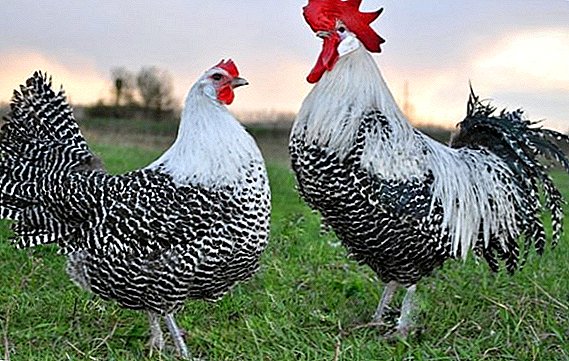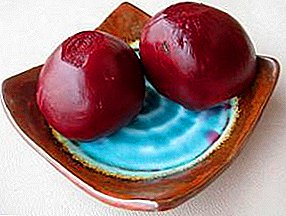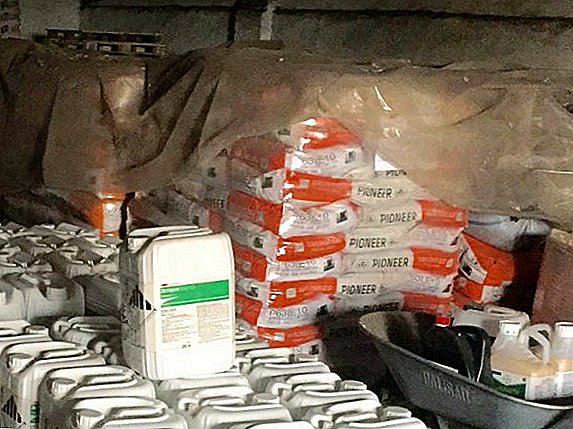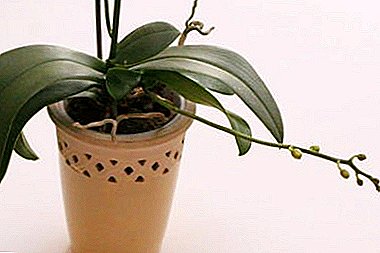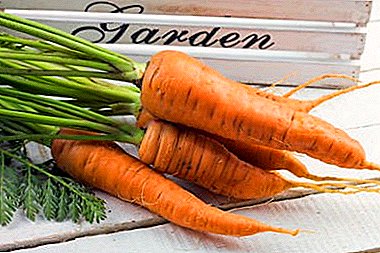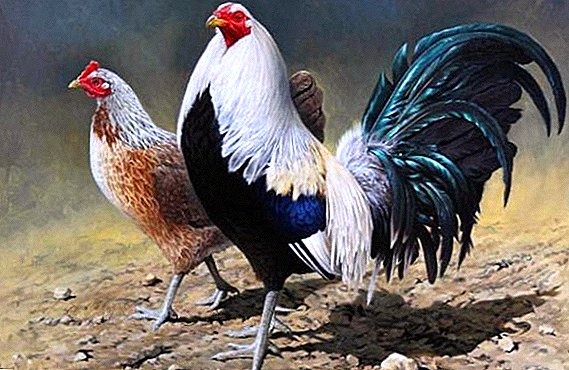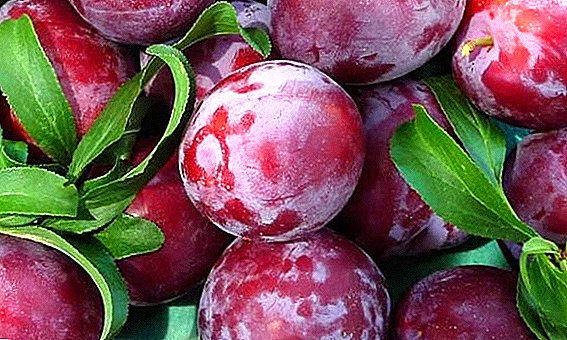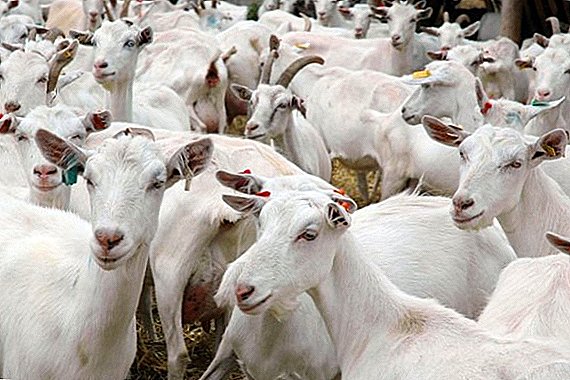 Breeding goats in the household involves their further slaughter and cutting. Observance of the correct technology of animal slaughter will allow keeping its skin and fur covering in a good condition, and will also have a positive effect on the taste of meat. How to correctly slaughter a goat and divide the carcass, let's see.
Breeding goats in the household involves their further slaughter and cutting. Observance of the correct technology of animal slaughter will allow keeping its skin and fur covering in a good condition, and will also have a positive effect on the taste of meat. How to correctly slaughter a goat and divide the carcass, let's see.
Preparatory work before slaughter
Goat slaughter requires careful preparation, the main stages of which are considered:
- Vaccination. If the animal carcass is planned to be sold on the market, then before slaughter, approximately 3 weeks later, vaccination and treatment with anthelminthic drugs and insecticides should be carried out. Such activities will protect the meat from the development of various ailments, free from possible internal and external pests.
- Nutrition. The day before the upcoming procedure, it is necessary to stop feeding the goat in order to free its gastrointestinal tract. The intestines full of food are rather poorly drawn out from the peritoneum of a dead animal. In addition, there is a high risk of damage to the intestines and the release of its contents to fresh meat.
- Water. Instead of feeding, the goat is provided with a sufficient amount of water, which, according to experienced breeders, makes the meat more tender and juicy.
- Cropping Immediately before the slaughter of a mature goat, it is recommended that it be castrated, otherwise its meat will have a specific, very unpleasant smell, which will be problematic to get rid of.
- A place. Equally important is the cleanliness of the place where the animal will be slaughtered. It is imperative to find a "secluded" corner with good bright lighting, away from other animals, carefully sanitized, freed from foreign objects, install a special crucifix for hanging carcasses. The crucifix should be positioned in such a way that the hind legs of the goat are wide apart and firmly fixed.
- Instruments. Particular attention should be paid to the choice of tools for slaughtering. The ideal option is a sharply-cut knife, with a comfortable, non-slip, fairly lightweight handle that can be securely fixed in your hand and does not slip out during the event.
Important! At the time of slaughter, it is imperative to check the state of health of the animal. At the slightest symptoms of ailments, the slaughter procedure should be postponed.
How to slaughter a goat
The purpose of slaughtering a goat is to get tasty and healthy meat. However, during the procedure we should not forget about its humanity. There are several basic technologies of slaughter, among which we note the most popular. 
With stunning
One of the most humane methods of slaughtering is preliminarily stunning a goat with an ax or hammer. Its main disadvantage is a significant difficulty in the process of releasing blood. As a rule, in industrial shops or on large farms, stuns with a discharge of electric current are used.
Important! In this case, when stunning the animal, you should act quickly and decisively - stun, open the artery and immediately hang it by the hind feet. This will quickly release the carcass from the blood.
Home technology is quite simple:
- With an ax, hammer or other blunt object hit hard on the head.
- Cut the neck artery.
- The carcass is suspended from the pole, completely bleed all the blood.
With pre-hanging
For the slaughter of a goat by the method of preliminary hanging it is recommended to use a sharp, awl-shaped blade instead of the usual knife, with which you can make a small but precise puncture. 
The procedure consists of the following steps:
- Live cattle hang on the struts head down, hind limbs tied.
- A sharp blade makes a puncture in the artery around the neck.
- The carcass is left in limbo until all the blood is out.
Did you know? The goat is a rather intelligent and intuitive animal that is acutely felt by even the slightest changes in the behavior and emotions of the host. Unfortunately, the livestock breeder will not be able to slaughter a goat from its own farm without giving out its emotions, so experts advise using third-party services to hold such a delicate event.
Horizontal hold
The method of slaughter with horizontal fixation of the animal is based on the following stages:
- The front and rear legs of a cattle are securely tied.
- The goat is placed on a flat surface on one side so that the head and neck extend beyond the edge of the base.
- Bottom of the head set capacity for collecting blood, for example, a wide basin.
- With a sharp knife, precise movement cut the throat.

With saddling
One method of slaughtering a goat is based on its preliminary saddling.
The process is carried out in this way:
- The cattle is saddled on top, in parallel they fix the head between the knees, the head is lifted up, firmly clamp the mouth with the hand.
- Precise, sharp movement cut the main blood vessels in the throat.
- The animal is held tightly until it stops moving.
- The carcass is suspended on a crucifix and provide free flow of blood.
Did you know? Goat meat is a traditional, most popular type of meat in Africa, Asia and America. It is here among all the meat products consume more than 70% of goat meat.
How to cut up the carcass
The next stage after the slaughter of the animal is carving. It is much more difficult to do this procedure than to slaughter a goat, since an event requires skill, a firm hand and accuracy. 
Carcass cutting is carried out according to the following algorithm:
- circular cuts are made, slightly above the line of the race joint, around the hooves and on the inside of the limbs;
- make the main long incision, starting from the neck, through the peritoneum and ending with the anus;
- cut through the tail area in a circle;
- using two hands, the skin from the carcass in the direction "from top to bottom";
- in the process of skinning, that is, skinning, help with a knife that allows you to separate the skin in the joints;
- after the skin has been removed, the peritoneum is gently ripped along the light line, the internal organs are pulled out: the bladder, genitals, intestines, liver, spleen, etc. In this procedure, they act extremely carefully to avoid pouring the contents of the intestine and bladder onto the meat. It is important to adhere to the sequence of organ removal: first, the bladder, anus, genitals, the second - the organs of the digestive tract (intestines, esophagus, stomach), the third - the gallbladder and glands, the latter - the liver (kidneys, liver, heart);
- after removing the organs, the inner surface is washed with cool water, dried with a dry, clean towel, and the remnants of blood clots and mucus are removed.
Learn more about tips and advice for beginner goats.
What to do with the skin
After removal of the skin from the carcass, it is recommended to conserve it. 
For this:
- it is placed on a clean, disinfected surface, abundantly covered with salt;
- the skin on top is sprinkled with salt in a rather thick layer;
- salt gently rubbed into the skin, then rolled up with a roll of the inner part in the middle;
- curved edges straighten, abundantly rub with salt.
In this form, keep the skin for one week. The readiness of the material can be easily determined by the color change: the skin from the inside acquires a beautiful bronze tint. The storage temperature of the pelt should be at least + 8 ° C.
Important! If the procedure for the preservation of the skin is carried out in the cold season, then you need to ensure that it does not freeze, because in this form it will begin to burst and crack.
Properties goat meat
Despite the fact that the shops are full of various kinds of meat products, it is rather difficult to find goat meat in a wide range. Goat meat does not cause great demand among modern consumers, and it is in vain, because it has a range of useful components that allow you to normalize the work of many internal systems of the human body.
Taste qualities
Despite the fact that there is a perception of the specific taste and aroma of goat meat, it has an excellent taste and neutral smell. An unpleasant odor can occur in a goat's meat only if the basic rules for cutting carcasses are not followed, when the contents of the bladder or intestines are fallen on the flesh during the removal of meat.  Unpleasant flavor and coarse structure has the meat of an old or unfiltered animal. With proper skinning, young goat meat is very juicy, tender, extremely tasty and, in addition, delicious. 100 g of the product contains 216 kcal.
Unpleasant flavor and coarse structure has the meat of an old or unfiltered animal. With proper skinning, young goat meat is very juicy, tender, extremely tasty and, in addition, delicious. 100 g of the product contains 216 kcal.
Its nutritional value is as follows:
- proteins - 18-20%;
- fats - 16-18%;
- carbohydrates - 0%;
- water - 80%.
You will be interested to know how much milk a goat gives per day.
Benefit
The rich chemical composition of goat meat determines a large range of its useful qualities.
It includes:
- Vitamins: a group of vitamins B, A, E, PP.
- Amino acids: valine, lysine, leucine, threonine, tryptophan.
- Micro- and macronutrients: phosphorus, sodium, sulfur, magnesium, zinc, chlorine.
However, the greatest value is protein, which is more than 20%. The protein composition is represented by a number of unique proteins that are easily absorbed by the human body. 
By eating goat meat regularly, you can:
- normalize the functioning of the digestive organs: the digestive tract, the intestines;
- strengthen the immune system, increase the protective functions of the body;
- restore the functions of the reproductive system, in particular, the prostate gland;
- reduce the level of "bad" cholesterol in the blood;
- strengthen the walls of blood vessels, improve the work of the cardiovascular system;
- improve the condition of the skin, hair and nails;
- normalize metabolic processes.
Harm and contraindications
There are no particular contraindications to eating goat meat. The only prohibition for the reception of goat meat is considered individual intolerance. However, according to statistics, such negative reactions to goat meat are extremely rare.
Read also how to determine pregnancy in a goat at home.
Goats are of high value in the household and are a source of not only healthy dairy products, but also dietary meat. However, in order to get fresh, nourishing meat, without a specific smell, one should strictly follow the basic principles of slaughter and carcass cutting techniques when slaughtering an animal.


